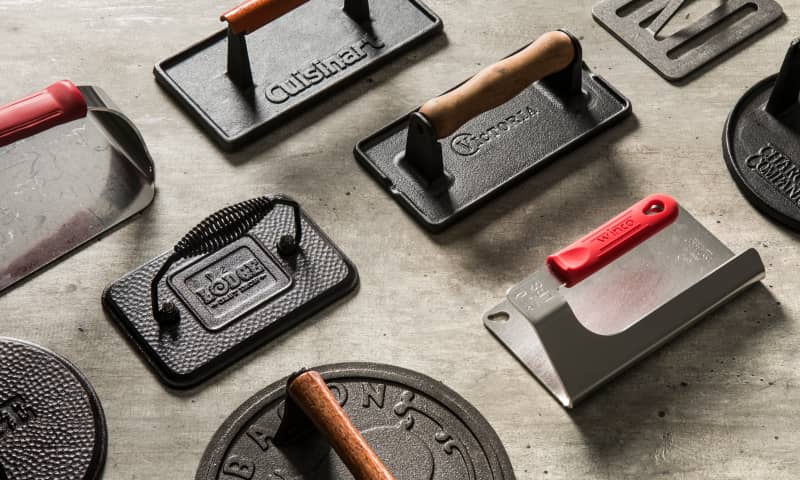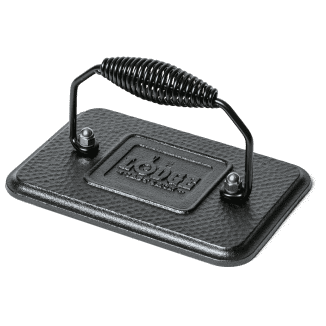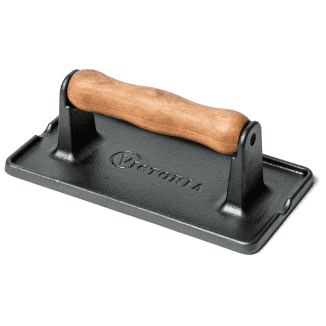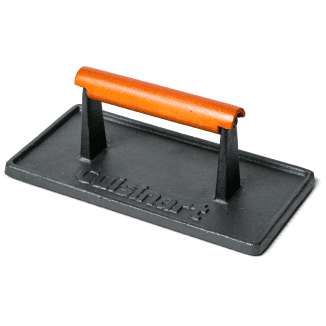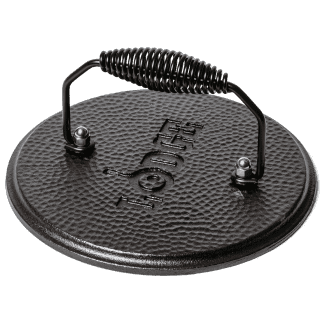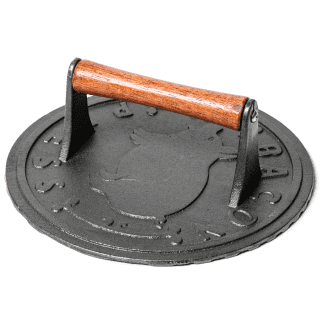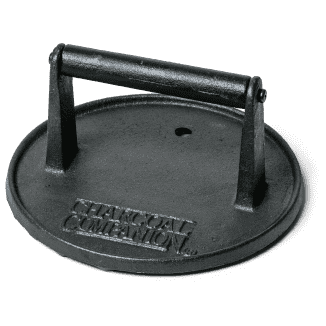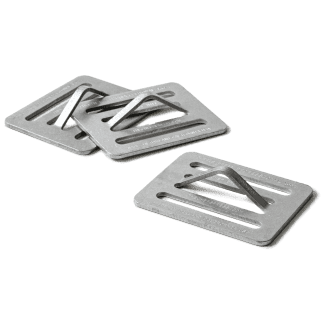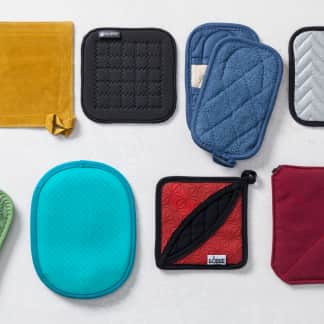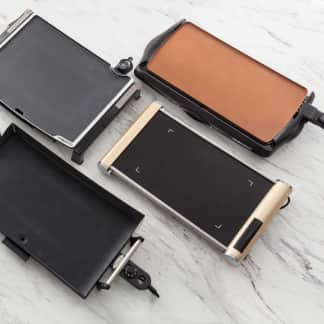Grill presses, sometimes called bacon presses or steak weights, are heavy metal disks or rectangles that are placed on top of food as it cooks in a skillet or on a griddle. These weights press food against the cooking surface, preventing the food from curling or buckling as it cooks and ensuring that it browns evenly and completely. In diners, it’s common for professional short-order cooks to use grill presses to pin down steaks, burgers, fish fillets, sandwiches, and strips of bacon on the flat-top grills from which the presses get their name. We wanted to find out if these tools had a place in home kitchens, so we bought nine models, priced from about $11 to about $38, and used them while cooking bacon, grilled cheese sandwiches, and panini and while pan-searing salmon fillets, steaks, and burgers.

Dimensions Were Key
Testers were wowed by almost all the food we cooked with the grill presses. Salmon emerged with skin that was perfectly crisped, with no flabby spots and no buckling. Steaks had deep brown crusts from edge to edge on both sides—an impressive feat, considering that it can be a challenge to get a great sear on the second side of a steak after flipping it. Grilled cheese sandwiches sported dense, uniformly brown, and crunchy exteriors.
Still, a few factors made certain models easier to use and helped them perform better than others. Shape didn’t matter—round and rectangular models were equally successful—but surface area did. In general, it’s a good idea to use a press that’s at least as big as the food you’re cooking; the press can’t weigh down food it doesn’t touch. However, bigger wasn’t necessarily better: Although large presses of 40 square inches or more—about the size of a salad plate—could sometimes cover two or more pieces of food at a time, they usually didn’t perform very well when they did, delivering wan, wet salmon fillets, steaks, and burgers. Why? After a little experimentation, it became clear: The larger presses acted like lids, trapping heat and steam above and between the pieces of food, inhibiting the food’s ability to brown before it was cooked through.
Since larger models couldn’t effectively press more food at a time, we found we preferred smaller presses that were easier to maneuver and balance on foods—especially foods with rounded or irregular surfaces, such as the salmon fillets. Smaller presses also allowed us to more easily see the food as it was cooking so we could judge its doneness. A surface area of about 30 square inches (roughly the size of a paperback book) was ideal—big enough to press a large steak without becoming unwieldy.
Weight Was Equally Important
The weight of the press was also critical. Models that weighed less than 1 pound didn’t always produce a good sear, instead allowing salmon fillets to buckle in the hot skillet and leaving parts of their skin flabby. But presses weighing more than 4 pounds were too heavy: Though they were great at smashing burgers into crisp patties, these models compressed the rounded flesh of salmon fillets and pushed the melting cheese from the sandwiches. Models that weighed from 1.5 to 2.5 pounds were best overall—these presses were heavy enough to flatten most foods without damaging them.
Press Material And Texture Also Mattered
We also considered the material and texture of the press surface. In general, we preferred presses made from cast iron, as they retained heat better than models made from stainless steel. Presses of both materials can be preheated directly on the stovetop and used to brown the top of food as it simultaneously browns on the bottom, saving time and helping ensure well-cooked food. But because stainless-steel models don’t retain heat as well as cast-iron models do, they don’t sear the top of food quite as deeply. They also discolor after being heated, though this doesn’t affect their functionality. In addition, because their cooking surfaces are relatively slick and smooth, stainless-steel models can be harder to position securely atop rounded pieces of food, such as salmon fillets. On the other hand, cast-iron models require a little more care and maintenance; unlike stainless-steel models, which are dishwasher-safe, cast-iron models must be washed and dried by hand to prevent rusting and may occasionally need to be wiped with oil to help keep water out. Still, we didn’t find these extra steps to be much of an imposition considering the impressive performance that the cast-iron models offered.

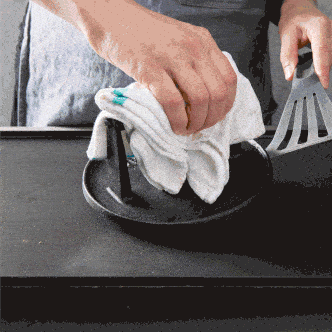
We had a slight preference for cast-iron presses with relatively smooth surfaces to those with pronounced ridges or bumps. When they were preheated, the ridged or bumpy presses effectively branded foods, and although these grill marks were attractive, testers preferred the uniform, deep-brown crusts and crispy, crunchy exteriors created by preheated smooth presses. The textured presses were also harder to preheat on electric stoves and slightly harder to clean, requiring us to detail any grooves or indentations to extract stray bits of hamburger or melted cheese.
Consider The Handles
Finally, we examined the handles. We liked presses with handles that rose at least 2 inches above the cooking surface; handles that sat lower were harder to grab with a towel or pot holder and positioned our fingers too close to the skillet surface. Handles molded from the same cast iron as the cooking surface were also dangerous, since heat spread from the surface to the handles, making them too hot to hold. Handles made from less conductive steel stayed cooler, especially when they were sheathed in protective silicone covers; these covers also made them particularly easy to grip, even when spattered with grease. Wood handles stayed relatively cool and were easy to grip, too, but were prone to damage, with one model sending a splinter into one tester’s hand and another absorbing water and splitting slightly over the course of testing.

The Best Grill Press: Lodge Rectangular Cast Iron Grill Press 6.75" X 4.5"
We think that many home cooks would benefit from keeping a grill press around. While a press can successfully handle only one piece of food at a time, the press improves the quality of that food immensely, ensuring picture-perfect browning every time. Our favorite is the Lodge Rectangular Cast Iron Grill Press 6.75" x 4.5". With a surface area of about 30 square inches, its smooth cast-iron cooking surface is just the right size for handling most foods. It helped sear and brown foods marvelously and was especially effective when preheated. And while its tall, galvanized steel handle is a little slippery, it stays relatively cool (at least during shorter stints on the stove). Weighing 2.9 pounds, it’s a touch heavier than ideal, so soft grilled cheese sandwiches sometimes got a little flatter than we would have preferred. Still, we think its superior performance and easy cleanup more than make up for this very minor issue.
- Surface area of about 30 square inches, which was large enough to cover food but small enough to easily maneuver
- Moderate weight so food was flattened but not crushed
- Smooth, not ridged or bumpy, surface that provided the most even browning
- Press made of cast iron that retained heat and effectively browned the top of food
- Large handle that rose at least 2 inches above the press surface and stayed cool during use
- Nine products, priced from about $11 to about $38
- Use when cooking bacon
- Use when cooking grilled cheese sandwiches and panini
- Use when searing salmon fillets
- Use when searing steaks
- Use when smashing and searing burgers
- Wash and dry after every use according to manufacturer's instructions
